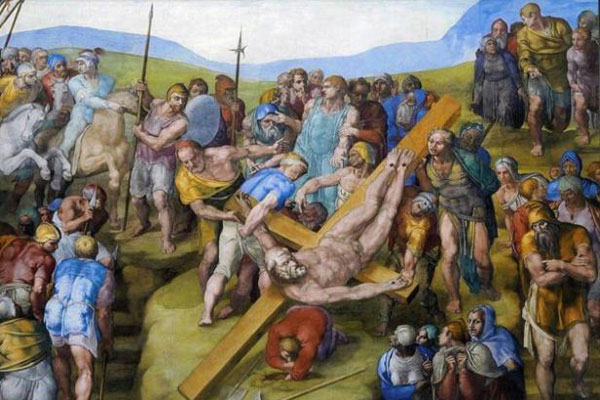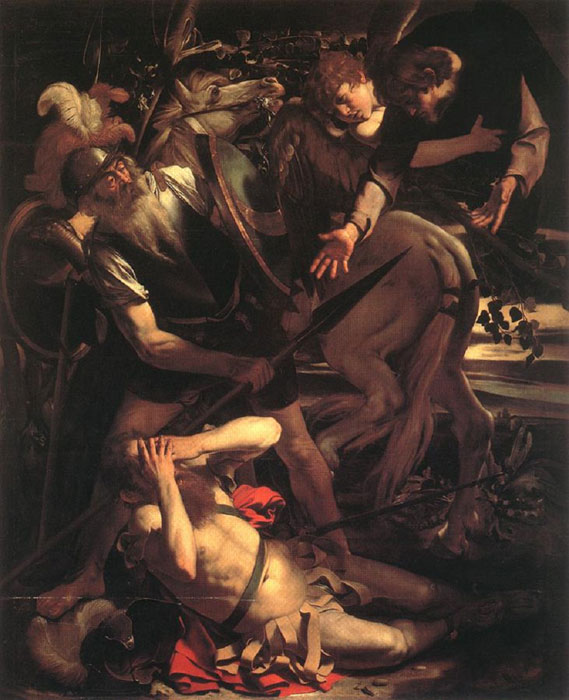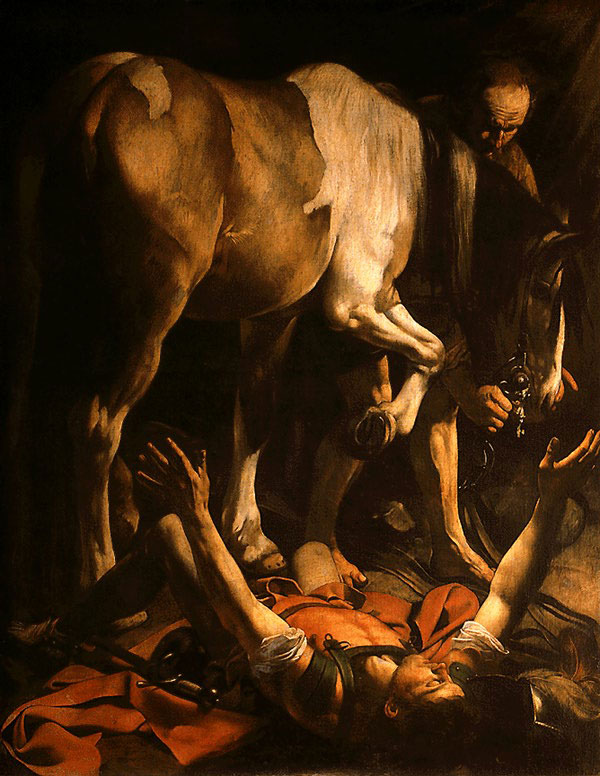Caravaggio Borrows from Michelangelo

Michelangelo, Crucifixion of Saint Peter, Pauline Chapel,
By Cornelius Sullivan
Caravaggio would use the poses that Michelangelo had worked out for his own figures with mixed results. In fact Caravaggio’s first paintings of both events using what he learned from Michelangelo were rejected.
However, Caravaggio’s second version of The Crucifixion of Saint Peter was a success. You can see that he directly took Saint Peter looking out at the viewer, he copied the hole in the ground, the crouching figure, and the shovel. Also he used the other muscular workers exerting real effort to carry out this task. Saint Peter asked to be Crucified upside down because he was not worthy to be killed like his master. The Romans were professionals at this, they accommodated him but it required some creativity and effort.

Crucifixion of Saint Peter, Santa Maria del Popolo, Rome
The success of Michelangelo’s Sistine Chapel paintings was monumental. Goethe said “Without having seen the Sistine Chapel one can form no idea of what one man is capable of achieving.”-1. Pope Paul became close friends with Michelangelo right after he was elected pope. The old pope said to the old artist, I have waited so long for this moment to commission you, you can not turn me down. He commissioned the Last Judgment twenty five years after the Sistine ceiling was finished. Then, the paintings in the Pauline Chapel followed and Michelangelo was seventy six when he finished them. Pope Paul appointed him architect of Saint Peters Basilica where he served until his death. William Wallace remarks on the friendship between artist and pope. “When the artist’s nephew sent fine Tuscan wines and fruits to

Michelangelo, Conversion of
In the first version of The Conversion of Saint Paul he used Michelangelo’s Jesus looming out of Heaven. It works in Michelangelo’s other worldly monumentality, this is a commanding Jesus reaching out from Heaven. Caravaggio, being more of a realist, had to support Jesus with an angel. It is an awkward wrestling like entanglement. And Jesus, though God made man, was a little too much a man in the dark, not himself the light, and we are not sure if that young angel can save him from being impaled on that lance. The painting is cluttered. That painting was rejected and it is now in the Odescalchi Collection in

Caravaggio, First Version, The Conversion of
I experienced a moment of disappointment when in 2006 I went to Santa Maria del Popolo to see the Caravaggio paintings. There was an especially large crowd outside the church and inside I could not even get close to the Cerasi Chapel. I thought, this now is the state of the world, tourist saturation has made art inaccessible. After I left, outside, I saw the big banner (which I had walked under) announcing the installation of the first version of The Conversion of Saint Paul opposite the newer painting. Thankfully it was a temporary exhibition, the opportunity to see the two paintings side by side. Santa Maria del Popolo is open for hours typical of many churches in Rome.The Pauline Chapel is not part of the normal self guided tour of the Vatican Museums. Like the Sistine Chapel it is a private chapel of the pope. It was at one time also used for papal conclaves. It was cleaned and restored ending in 2009. There remains some criticism for not removing later additions, things that were not of Michelangelo, on Saint Peter the loin cloth and the nails. Covering the nudity is about propriety but the addition of the nails changed the meaning and therefore the theology. Michelangelo explains Saint Peter’s acceptance of martyrdom by the saint willingly assuming the pose.

Caravaggio, The Conversion of
Santa Maria del Popolo,
Francine Prose talks about the brilliance of the final painting. She says comparing first and second versions, “The crowd is gone, the angels are gone, only these three creatures remain.” And, “ …Paul is more like Caravaggio himself, a man for whom a more extreme and drastic awakening was required.” And, “…Caravaggio has given us a way to imagine that what we are being shown is a moment of eternity, a frozen glimpse of forever.” -3.
We do not need to be told the story, we know it. The divine presence is better felt when not seen.
Michelangelo Buonarroti was born into the beginning of the Renaissance in
1. Goethe, Italian Journal, 1783
2. William Wallace, Michelangelo, 2010, p. 182.
3. Wallace, p. 182
4. Francine Prose, Caravaggio, 2005, p. 74, 75.